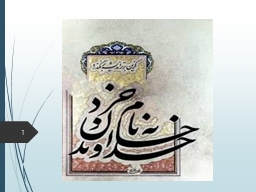

hajhashemy OBGYN Fellowship of Pelvic Floor 2 Definition OAB defined based on symptoms Urgency with or without urge incontinence usually with frequency and nocturia In the absence of pathological or metabolic ID: 1036041
Download Presentation The PPT/PDF document "1 Overactive bladder Maryam" is the property of its rightful owner. Permission is granted to download and print the materials on this web site for personal, non-commercial use only, and to display it on your personal computer provided you do not modify the materials and that you retain all copyright notices contained in the materials. By downloading content from our website, you accept the terms of this agreement.
1. 1
2. Overactive bladderMaryam hajhashemyOB,GYN / Fellowship of Pelvic Floor2
3. DefinitionOAB defined based on symptomsUrgency, with or without urge incontinence, usually with frequency and nocturiaIn the absence of pathological or metabolic conditions that might explain these symptoms3
4. 4 The amount of leakage ranges from a few drops to completely soaked undergarments.
5. 5
6. 6
7. 7
8. 8Urgency incontinence is more common in older ( comorbid conditions )It is believed to result from detrusor overactivityThis may be secondary to neurologic disorders ( spinal cord injury), bladder abnormalities, or may be idiopathic.
9. EVALUATION 9
10. 10The initial evaluation of urinary incontinence includes :1 - characterizing and classifying the type of incontinence2 - identifying underlying conditions ( neurologic disorder or malignancy) that may manifest as urinary incontinence.3 - identifying potentially reversible causes of incontinence.
11. 11Do you go to the toilet more than 8 times a day? Do you often wake up during the night needing to go to the toilet?Do you have to hurry to make the toilet in time?Do you often not reach the toilet in time?
12. 12Voiding diaries 1 - urinary incontinence is associated with high fluid intake.2 - severity of the problem3 - identify the maximum time interval that the woman can reasonably wait between voids, a measure used to guide bladder training.
13. 13
14. 14
15. 15Impact on quality of lifesymptoms that are most bothersome to the patient-International Consultation on Incontinence Questionnaire-Kings Health Questionnaire -Pelvic Floor Distress Inventory -Pelvic Floor Impact Questionnaire -Patient Global Impression of Improvement (PGII) -Patient Global Impression of Severity (PGIS)
16. Physical examination 1 - vaginal atrophy2 - pelvic masses 3 - pelvic organ prolapse16
17. Laboratory testsUrinalysisInfection u/cHematuria cytology GlycosuriaProteinuriaRenal functionurinary retention17
18. Clinical tests cough stress test Post void residual Urodynamic testing Urethral mobility evaluation 18
19. Treatment 19
20. 20
21. INITIAL TREATMENT Lifestyle modification :1 - Weight loss 2 - Dietary changes 3 - Constipation4 - Smoking cessation21
22. 22
23. Supplemental modalities:* Supervised pelvic floor therapy * Vaginal weighted cones * Biofeedback23
24. Bladder trainingtimed voidingVoiding diaryUrgency between voiding intervals are gradually increasedTopical vaginal estrogen24
25. Pharmacologic therapy The combination of medication with behavioral therapy is more effectivecounsel patients to continue pelvic floor exercise and other behavioral therapies while initiating medical treatment.25
26. 26Antimuscarinics:They are thought to act primarily by increasing bladder capacity and decreasing urgency by blocking basal release of acetylcholine during bladder filling .
27. Antimuscarinic Agents There are six antimuscarinic agents available in different doses and formulations: oxybutynin tolterodine darifenacin solifenacin fesoterodine trospium27
28. 28 These are available in tow form:• Immediate-release• Extended- release
29. Adverse drug effects dry mouthdry eyesblurred visionTachycardiaConstipationDrowsinessDizzinessHeadachecognitive deficitsperipheral edema29
30. 30Dry mouth and constipation are the most common reason for discontinuation . Constipation and compensatory fluid intake for dry mouth may exacerbate urinary incontinence.
31. 31Contraindication:Gastric retentionAngle-closure glaucomaUrinary retention
32. 32post void residualwomen at higher risk for urinary retentionsymptoms worsenlarge pelvic organ prolapsetaking other medications with anticholinergic effects. Routine monitoring of post void residual in all patients on antimuscarinics is not needed.
33. 33Comparison of Antimuscarinic Agents No evidence for the superiority of one antimuscarinic agent over anotherExtended-release agents have lower rates of adverse effects than immediate release agents.
34. Choice of agent and dosing CostDosing frequencyDrug-drug interactionsPotential side effectsComorbid conditions34
35. 35Start with the lowest available dose Titrate up as needed after 2 weeksAssess response to treatment after four to six weeks12 weeks to have full efficacy. Avoid prematurely declaring treatment failure.
36. 36Insufficient improvement or unable to tolerate Different antimuscarinic or change in class of medication (mirabegron) Patients may respond to one antimuscarinic and not another
37. agent and dosingOxybutynin(Ditropan) tab:5,10mg 2.5to5mg /qid Tolterodin(Detrol) tab:1,2mg 1to2mg/ bidSolifenacin(vesicare) tab:5,10mg 5to10mg /dDarifenacin(Enablex) tab:7.5,15mg 7.5to15mg /d37
38. 38 Mirabegron beta adrenoceptor agonist1 - do not tolerate antimuscarinic medications2 - have contraindications to antimuscarinic medications3-add it to antimuscarinics for combination therapy in persistent symptoms
39. Thirdline therapiesRefractory urgency incontinence symptomsTry at least one or two pharmacotherapies Referred to a specialist39
40. 40Third line therapies include:Acupuncture Botulinum toxin injectionPercutaneous tibial nerve stimulationSacral neuromodulation (SNM)
41. SURGERY ???41
42. 42 These may include :1 - Augmentation cystoplasty 2 - Urinary diversion3 - Placement of a suprapubic catheter
43. 43